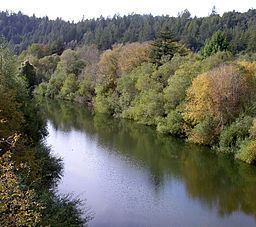- left East Austin Creek - elevation 23 ft (7 m) | - elevation 1,965 ft (599 m) | |
 | ||
- right Bearpen Creek, Kidd Creek - location 1 mi (2 km) north of Duncans Mills, California | ||
Summer time on austin creek
Austin Creek is a 16.0-mile-long (25.7 km) southward-flowing stream in the mountains of western Sonoma County, California which empties into the Russian River about 4 miles (6 km) from the Pacific Ocean.
Contents
- Summer time on austin creek
- East austin creek salmon part 1
- CourseEdit
- HistoryEdit
- Sonoma Magnesite CompanyEdit
- Sonoma Magnesite TramwayEdit
- Habitat and pollutionEdit
- BridgesEdit
- References
East austin creek salmon part 1
CourseEdit
The creek originates in an isolated area known as The Cedars, about 13 miles (21 km) west of Healdsburg, California. It flows south past Layton Mine into a wooded canyon, where it joins King Ridge Road just above its confluence with Bearpen Creek. It parallels King Ridge Road to the town of Cazadero and continues south through confluences with East Austin Creek and Kidd Creek. It flows under State Route 116 at milepost 4.93 and enters the Russian River about 1 mile (1.6 km) north of the town of Duncans Mills.
HistoryEdit
In the 1885-1886, the North Pacific Coast Railroad (NWP) extended its narrow-gauge line up Austin Creek to transport lumber from Cazadero to points south. The railroad grade was later converted to road, becoming Cazadero Highway.
Sonoma Magnesite CompanyEdit
The Cedars is a distinctive woodland of trees able to grow on a formation of Mesozoic intrusive ultramafic rock. Sonoma Magnesite Company was formed in 1912 to mine the Red Slide Deposit of magnesite in The Cedars. The mineral is important for steel-making and manufacture of bricks for high-temperature applications; but cost of transportation made mining in The Cedars infeasible until World War I interrupted availability of less expensive sources. The Sonoma Magnesite Tramway, an eleven-mile-long, 2 ft (610 mm) narrow gauge industrial railway was built in 1914 along the bank of East Austin Creek to connect the mine with Magnesia station on the NWP railroad south of Cazadero. Thirty tons of ore were calcined daily in an oil-fired rotary kiln and packed into sacks for shipping. Production ended in 1920 when magnesite again became available from less expensive sources.
Sonoma Magnesite TramwayEdit
The railway shipped sacks of magnesite on 4-wheel flatcars. Each of the ten flatcars was four feet wide by seven feet long and could be loaded with 5 tons of magnesite. Oil for the kiln was shipped in six 500-gallon tank cars eight feet long. Trains were pulled by an unusual variety of locomotives:
High water in East Austin Creek washed out significant portions of the tramway in 1921; and Betsy was washed downstream and partially buried in the gravel channel. Most of the rails had been salvaged by 1925; and Betsy was converted to scrap metal in 1961.
Habitat and pollutionEdit
As of 2000, Austin Creek and all its major tributaries all supported steelhead trout. Austin Creek and East Austin Creek also harbored California freshwater shrimp.
In 2016, scientists found evidence of methane-producing microbes in water coming from underground at The Cedars, the first time methanogens that thrive in harsh environments have been discovered beyond the ocean floor.
BridgesEdit
Many bridges span Austin Creek. The longest of these is the State Route 116 bridge, which is 380 feet (120 m) long and was built in 1962.
